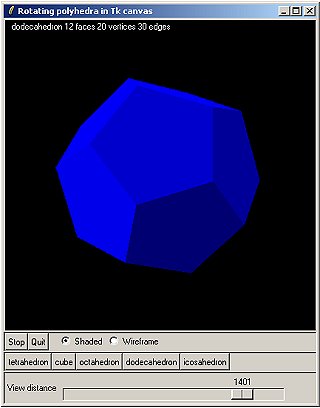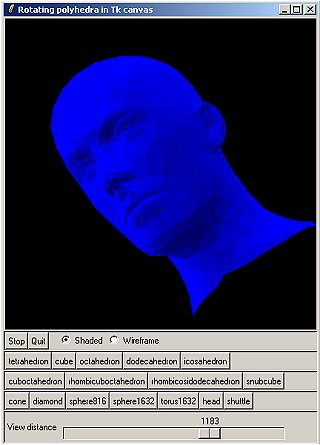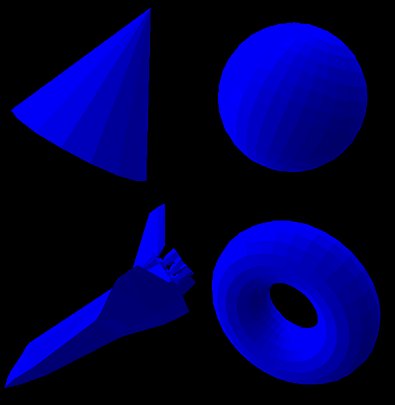Version 8 of 3D polyhedra with simple tk canvas
Updated 2005-06-02 07:04:49 by AMGS - This code displays 3d polyhedra in shaded or wireframe mode. It uses only the tk canvas. The illumination model is a simple flat shading model [L1 ]. The color intensity of a face is proportional to the angle between its normal and a light direction.


- A starkit version with more demos is available at [L2 ]
- A lightweight tclet version can be seen at [L3 ] (sources [L4 ])
The hidden face removal algorithm works well with convex objects but is very limited for the others. See for instance the torus or the shuttle example.


PWQ 2 May 05, moved bind command to after package require Tk!
# polyhedra.tcl
# Author: Gerard Sookahet
# Date: 30 Mai 2005
# Description: Rotating polyhedra using a 'standard' tk canvas.
# Flat shading and wireframe mode.
package require Tk 8.4
bind all <Escape> {exit}
proc Barycenter {lcoords} {
set X 0
set Y 0
set n [llength $lcoords]
foreach vtx $lcoords {
foreach {x y} $vtx {
set X [expr {$X + $x}]
set Y [expr {$Y + $y}]
}
}
return [list [expr {$X/$n}] [expr {$Y/$n}]]
}
proc CrossProduct {x1 y1 z1 x2 y2 z2} {
return [list [expr {$y1*$z2 - $y2*$z1}] \
[expr {$z1*$x2 - $z2*$x1}] \
[expr {$x1*$y2 - $x2*$y1}]]
}
proc DotProduct {x1 y1 z1 x2 y2 z2} {
return [expr {$x1*$x2 + $y1*$y2 + $z1*$z2}]
}
proc MatrixVectorProduct {M V} {
set x [lindex $V 0]
set y [lindex $V 1]
set z [lindex $V 2]
return [list [expr {[lindex $M 0 0]*$x+[lindex $M 1 0]*$y+[lindex $M 2 0]*$z}] \
[expr {[lindex $M 0 1]*$x+[lindex $M 1 1]*$y+[lindex $M 2 1]*$z}] \
[expr {[lindex $M 0 2]*$x+[lindex $M 1 2]*$y+[lindex $M 2 2]*$z}]]
}
proc MatrixProduct {M1 M2} {
set M {{0 0 0 0} {0 0 0 0} {0 0 0 0} {0 0 0 0}}
for {set i 0} {$i<4} {incr i} {
for {set j 0} {$j<4} {incr j} {
lset M $i $j 0
for {set k 0} {$k<4} {incr k} {
lset M $i $j [expr {[lindex $M $i $j]+[lindex $M1 $i $k]*[lindex $M2 $k $j]}]
}
}
}
return $M
}
proc MatrixRotation { ax ay az } {
set sax [expr {sin($ax)}]
set cax [expr {cos($ax)}]
set say [expr {sin($ay)}]
set cay [expr {cos($ay)}]
set saz [expr {sin($az)}]
set caz [expr {cos($az)}]
set Mx {{1 0 0 0} {0 0 0 0} {0 0 0 0} {0 0 0 1}}
set My {{0 0 0 0} {0 1 0 0} {0 0 0 0} {0 0 0 1}}
set Mz {{0 0 0 0} {0 0 0 0} {0 0 1 0} {0 0 0 1}}
# Rotation matrix around X axis with angle ax
lset Mx 1 1 $cax
lset Mx 1 2 $sax
lset Mx 2 1 [expr {-1*$sax}]
lset Mx 2 2 $cax
# Rotation matrix around Y axis with angle ay
lset My 0 0 $cay
lset My 0 2 [expr {-1*$say}]
lset My 2 0 $say
lset My 2 2 $cay
# Rotation matrix around Z axis with angle az
lset Mz 0 0 $caz
lset Mz 0 1 $saz
lset Mz 1 0 [expr {-1*$saz}]
lset Mz 1 1 $caz
return [MatrixProduct [MatrixProduct $Mx $My] $Mz]
}
# Compute normal vector and norm for each face
# -------------------------------------------------------------------
proc NormalVector {lvtx lcnx} {
set lnv {}
set lmv {}
foreach face $lcnx {
foreach {nx ny nz} [CrossProduct \
[expr {[lindex $lvtx [lindex $face 1] 0] - [lindex $lvtx [lindex $face 0] 0]}] \
[expr {[lindex $lvtx [lindex $face 1] 1] - [lindex $lvtx [lindex $face 0] 1]}] \
[expr {[lindex $lvtx [lindex $face 1] 2] - [lindex $lvtx [lindex $face 0] 2]}] \
[expr {[lindex $lvtx [lindex $face 2] 0] - [lindex $lvtx [lindex $face 1] 0]}] \
[expr {[lindex $lvtx [lindex $face 2] 1] - [lindex $lvtx [lindex $face 1] 1]}] \
[expr {[lindex $lvtx [lindex $face 2] 2] - [lindex $lvtx [lindex $face 1] 2]}]] {}
lappend lnv [list $nx $ny $nz]
lappend lmv [DotProduct $nx $ny $nz $nx $ny $nz]
}
return [list $lnv $lmv]
}
# 2D projection
# -------------------------------------------------------------------
proc Projection {x y z M} {
global scx scy vdist
set nx [expr {[lindex $M 0 0]*$x+[lindex $M 1 0]*$y+[lindex $M 2 0]*$z}]
set ny [expr {[lindex $M 0 1]*$x+[lindex $M 1 1]*$y+[lindex $M 2 1]*$z}]
set nz [expr {([lindex $M 0 2]*$x+[lindex $M 1 2]*$y+[lindex $M 2 2]*$z+10)/$vdist}]
return [list [expr {$nx/$nz+$scx/2.0}] [expr {$ny/$nz+$scy/2.0}]]
}
# Apply transformations to vertex coordinates
# -------------------------------------------------------------------
proc Transformations {lvtx lnv} {
global ax ay az
update
set lnew {}
set lvn {}
# Compute matrix rotation
set M [MatrixRotation $ax $ay $az]
set i 0
# Apply projection
foreach vtx $lvtx {
lappend lnew [Projection [lindex $vtx 0] [lindex $vtx 1] [lindex $vtx 2] $M]
incr i
}
# Normal vector rotation
foreach v $lnv {lappend lvn [MatrixVectorProduct $M $v]}
return [list $M $lnew $lvn]
}
# Compute color entensity for each face
# -------------------------------------------------------------------
proc Intensity {lnv lmv lvv} {
set lclr {}
set v [DotProduct [lindex $lvv 0] [lindex $lvv 1] [lindex $lvv 2] \
[lindex $lvv 0] [lindex $lvv 1] [lindex $lvv 2]]
set i 0
foreach nv $lnv {
set clr 31
set a [DotProduct [lindex $nv 0] [lindex $nv 1] [lindex $nv 2] \
[lindex $lvv 0] [lindex $lvv 1] [lindex $lvv 2]]
set b [expr {sqrt([lindex $lmv $i]*$v)}]
set clr [expr {round(31*($a/$b))}]
lappend lclr [expr {$clr < 0 ? 31 : [expr {32 - $clr}]}]
incr i
}
return $lclr
}
# Start the display and rotation loop
# -------------------------------------------------------------------
proc DisplayModel {w s} {
global stop
global display
global ax ay az tx ty tz
$w.c delete all
set stop 0
set ax 0.2
set ay 0.1
set az 0.3
set tx 0
set ty 0
set tz 0
set d $display
foreach {t lvtx lcnx lclr} [ReadData $s] {}
$w.c create text 10 10 -anchor w -fill white -text $t
foreach {lnv lmv} [NormalVector $lvtx $lcnx] {}
set lpoly [DisplayInit $w $d $lcnx $lclr]
if {$d == "shaded"} then {
for {set i 1} {$i<=820} {incr i} {
if $stop break
set ax [expr {$ax-0.02}]
set az [expr {$az+0.02}]
set ay [expr {$ay+0.025}]
after 40
DisplayShaded $w $lpoly $lvtx $lcnx $lnv $lmv
}
} else {
for {set i 1} {$i<=820} {incr i} {
if $stop break
set ax [expr {$ax-0.02}]
set az [expr {$az+0.02}]
set ay [expr {$ay+0.025}]
after 40
Display $w $lpoly $lvtx $lcnx $lnv $lmv
}
}
}
# Data structure for models with vertices and connectivity
# -------------------------------------------------------------------
proc ReadData { n } {
set lvtx {}
set lcnx {}
set lclr {}
set txt ""
switch $n {
tetrahedron {
set txt "tetrahedron: 4 faces 4 vertices 5 edges"
set a [expr {1.0/sqrt(3.0)}]
set lvtx [list [list $a $a $a] [list $a -$a -$a] \
[list -$a $a -$a] [list -$a -$a $a]]
set lcnx {{0 3 1} {2 0 1} {3 0 2} {1 3 2}}
}
cube {
set txt "cube: 6 faces 8 vertices 12 edges"
set lvtx {{0.7 0.7 0.7} {-0.7 0.7 0.7} {-0.7 -0.7 0.7} {0.7 -0.7 0.7}
{0.7 0.7 -0.7} {-0.7 0.7 -0.7} {-0.7 -0.7 -0.7} {0.7 -0.7 -0.7}}
set lcnx {{4 7 6 5} {0 1 2 3} {3 2 6 7} {4 5 1 0} {0 3 7 4} {5 6 2 1}}
}
octahedron {
set txt "octahedron 8 faces 6 vertices 16 edges"
set lvtx {{1 0 0} {0 1 0} {-1 0 0} {0 -1 0} {0 0 1} {0 0 -1}}
set lcnx {{0 1 4} {1 2 4} {2 3 4} {3 0 4}
{1 0 5} {2 1 5} {3 2 5} {0 3 5}}
}
dodecahedron {
set txt "dodecahedron 12 faces 20 vertices 30 edges"
set s3 [expr sqrt(3)]
set s5 [expr sqrt(5)]
set alpha [expr {sqrt(2.0/(3 + $s5))/$s3}]
set beta [expr {(1.0 + sqrt(6.0/(3 + $s5) - 2 + 2*sqrt(2.0/(3.0 + $s5))))/$s3}]
set gamma [expr {1.0/$s3}]
set lvtx [list \
[list -$alpha 0 $beta] \
[list $alpha 0 $beta] \
[list -$gamma -$gamma -$gamma] \
[list -$gamma -$gamma $gamma] \
[list -$gamma $gamma -$gamma] \
[list -$gamma $gamma $gamma] \
[list $gamma -$gamma -$gamma] \
[list $gamma -$gamma $gamma] \
[list $gamma $gamma -$gamma] \
[list $gamma $gamma $gamma] \
[list $beta $alpha 0] \
[list $beta -$alpha 0] \
[list -$beta $alpha 0] \
[list -$beta -$alpha 0] \
[list -$alpha 0 -$beta] \
[list $alpha 0 -$beta] \
[list 0 $beta $alpha] \
[list 0 $beta -$alpha] \
[list 0 -$beta $alpha] \
[list 0 -$beta -$alpha]]
set lcnx {{0 1 9 16 5} {1 0 3 18 7} {1 7 11 10 9} {11 7 18 19 6}
{8 17 16 9 10} {2 14 15 6 19} {2 13 12 4 14} {2 19 18 3 13}
{3 0 5 12 13} {6 15 8 10 11} {4 17 8 15 14} {4 12 5 16 17}}
}
icosahedron {
set txt "icosahedron: 20 faces 12 vertices 30 edges"
set X 0.525731112119133606
set Z 0.850650808352039932
set lvtx [list [list -$X 0.0 $Z] [list $X 0.0 $Z] [list -$X 0.0 -$Z] \
[list $X 0.0 -$Z] [list 0.0 $Z $X] [list 0.0 $Z -$X] \
[list 0.0 -$Z $X] [list 0.0 -$Z -$X] [list $Z $X 0.0] \
[list -$Z $X 0.0] [list $Z -$X 0.0] [list -$Z -$X 0.0]]
set lcnx {{4 0 1} {9 0 4} {5 9 4} {5 4 8}
{8 4 1} {10 8 1} {3 8 10} {3 5 8}
{2 5 3} {7 2 3} {10 7 3} {6 7 10}
{11 7 6} {0 11 6} {1 0 6} {1 6 10}
{0 9 11} {11 9 2} {2 9 5} {2 7 11}}
}
}
for {set i 0} {$i <= [llength $lcnx]} {incr i} {
lappend lclr "0000[format %2.2x 255]"
}
return [list $txt $lvtx $lcnx $lclr]
}
# Initialization of canvas with polygonal objects filled or not
# -------------------------------------------------------------------
proc DisplayInit {w d lcnx lclr} {
set lpoly {}
set i 0
if {$d == "shaded"} then {
foreach cnx $lcnx {
lappend lpoly [$w.c create polygon \
[string repeat " 0" [expr {2*[llength $cnx]}]] \
-fill "#[lindex $lclr $i]"]
incr i
}
} else {
foreach cnx $lcnx {
lappend lpoly [$w.c create polygon \
[string repeat " 0" [expr {2*[llength $cnx]}]] \
-fill black -outline blue]
}
}
return $lpoly
}
# Flat shaded display with gradient color
# -------------------------------------------------------------------
proc DisplayShaded {w lpoly lvtx lcnx lnv lmv} {
update
set lgradB {}
foreach {M lnew lvn} [Transformations $lvtx $lnv] {}
# Light vector is set to <1 1 -1>
foreach i [Intensity $lvn $lmv [list 1 1 -1]] {
lappend lgradB [format %2.2x [expr {100+154*$i/32}]]
}
set i 0
foreach cnx $lcnx {
set lcoords {}
foreach j $cnx {lappend lcoords [lindex $lnew $j]}
# Backface culing for hidden face. Not removed but only reduced to a point
if {[lindex $lvn $i 2] < 0} {
eval $w.c coords [lindex $lpoly $i] [join $lcoords]
$w.c itemconfigure [lindex $lpoly $i] -fill "#0000[lindex $lgradB $i]"
} else {
$w.c coords [lindex $lpoly $i] [string repeat " [join [Barycenter $lcoords]]" [llength $cnx]]
}
incr i
}
}
# Wireframe display
# -------------------------------------------------------------------
proc Display {w lpoly lvtx lcnx lnv lmv} {
update
foreach {M lnew lvn} [Transformations $lvtx $lnv] {}
set i 0
foreach cnx $lcnx {
set lcoords {}
foreach j $cnx {lappend lcoords [lindex $lnew $j]}
# Backface culing for hidden face. Not removed but only reduced to a point
if {[lindex $lvn $i 2] < 0} {
eval $w.c coords [lindex $lpoly $i] [join $lcoords]
} else {
$w.c coords [lindex $lpoly $i] [string repeat " [join [Barycenter $lcoords]]" [llength $cnx]]
}
incr i
}
}
# -------------------------------------------------------------------
proc Main {} {
global stop
global display
global scx scy vdist
set w .tdc
catch {destroy $w}
toplevel $w
wm withdraw .
wm title $w "Rotating polyhedra in Tk canvas "
set display shaded
set scx 420
set scy 420
set vdist 1200
pack [canvas $w.c -width $scx -height $scy -bg white -bg black -bd 0]
$w.c delete all
set f1 [frame $w.f1 -relief sunken -borderwidth 2]
pack $f1 -fill x
button $f1.brun -text Stop -command {set stop 1}
button $f1.bq -text Quit -command exit
label $f1.l1 -text " "
radiobutton $f1.rbs -text "Shaded" -variable display -value shaded
radiobutton $f1.rbw -text "Wireframe" -variable display -value wireframe
eval pack [winfo children $f1] -side left
set f2 [frame $w.f2 -relief sunken -borderwidth 2]
pack $f2 -fill x
foreach i {tetrahedron cube octahedron dodecahedron icosahedron} {
button $f2.b$i -text $i -command "DisplayModel $w $i"
}
eval pack [winfo children $f2] -side left
set f3 [frame $w.f3 -relief sunken -borderwidth 2]
pack $f3 -fill x
label $f3.l1 -text "View distance "
scale $f3.sca -from 300 -to 1600 -length 300 \
-orient horiz -bd 1 -showvalue true -variable vdist
eval pack [winfo children $f3] -side left
}
MainPeter Newman 2 June 2005: This is without a shadow of doubt, the best piece of software I have ever seen/used (Charles Moore's Forth interpreter being it's only possible competition). Quake and Pov-Ray are all very powerful. But so complicated. And don't even talk about the rest. But you've got useful 3D, in a script language, on a Tk canvas, in a few A4 pages of code. Unbelievable!
But please make all my Christmases come true at once. How does one create the models? Please tell me that there's an equally easy to use and powerful modelling tool as well.
AM (2 june 2005) I have a few comments on this delightful starkit:
- Pressing the little x to close the application causes it to display messages about .tdc.c not being a valid command rather than closing the program.
- The hidden-surface algorithm is not perfect: it fails for instance with the torus
]